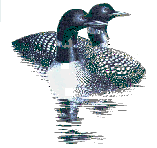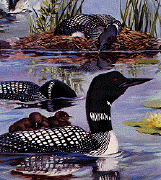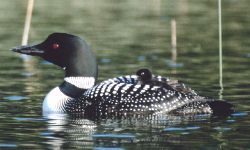








 |
The Loon Page
|
 THE
COMMON LOON
THE
COMMON LOON
 A LOON
STORY
A LOON
STORY
 IDENTIFICATION
TIPS
IDENTIFICATION
TIPS
 COMMON
LOON SOUNDS
COMMON
LOON SOUNDS

Who has ever paddled a canoe, or cast a fly, or
pitched a tent
in the north woods and has not stopped to listen to this wail of the
wilderness?
And what would the wilderness be without it?
- A.C. Bent
THE COMMON LOON (Gavia immer)
 This red-eyed black and white water-bird with a daggerlike beak is
most closely related to primitive birds and its soliloquy of cries can sound eerily
prehistoric. The loon is almost unchanged in body plan from Hesperornis, an aquatic bird
from 100 million years ago (a classic design). Loons are reclusive and solitary. Pairs
prefer a secluded lake or estuary that can support a diet of small fish and crustaceans.
They are excellent swimmers and can dive for minutes. Larger than most ducks, loons are
awkward and most vulnerable on land. Their thrashing water take-offs are lengthy and far
from graceful. Silent in winter, the loon repertoire of calls haunt the night with strange
laughter-like calls, falsetto wails and strange yodelling.
This red-eyed black and white water-bird with a daggerlike beak is
most closely related to primitive birds and its soliloquy of cries can sound eerily
prehistoric. The loon is almost unchanged in body plan from Hesperornis, an aquatic bird
from 100 million years ago (a classic design). Loons are reclusive and solitary. Pairs
prefer a secluded lake or estuary that can support a diet of small fish and crustaceans.
They are excellent swimmers and can dive for minutes. Larger than most ducks, loons are
awkward and most vulnerable on land. Their thrashing water take-offs are lengthy and far
from graceful. Silent in winter, the loon repertoire of calls haunt the night with strange
laughter-like calls, falsetto wails and strange yodelling.
Loons are water birds like ducks, geese, and grebes, but they are
classified separately by scientists. The five species are Red-throated Loon Gavia
stellata, Pacific Loon Gavia pacifica, Arctic Loon Gavia arctica,
Yellow-billed Loon Gavia adamsii, and Common Loon Gavia immer. The Common
Loon is the species best known to most of us, as its breeding range lies across most of
Canada. All five species of loons migrate to warmer areas around the Gulf of Mexico and on
the east and west coasts of North America to winter, and return to northern lakes to breed
when the ice melts in spring.
Most birds have hollow bones for low weight. The loon's bones are
solid to facilitate easy diving. These birds have been known to dive to depths of 600 feet
in pursuit of a fishy meal. They fly fast and low, despite being heavy. They're large
birds, nearly the size of Canada geese. The ruby eye of the loon is one of Nature's finest
fashion statements.
Sighting and hearing a loon is still considered a treat to any bird
lover. In Canada there is a strong loon population on the rise thanks to the efforts of
conservation groups and lake associations. If a loon is visiting your lake or shorefront,
learn how to encourage your guest to remain through the summer, then grab your binoculars
and a tape recorder to observe a truly unusual bird.
Loons arrive in pairs on northern lakes in the spring as soon as the
ice thaws. Loons are solitary nesters. Small lakes, generally those between 5 and
50 ha, can accommodate one pair of loons. Larger lakes may have more than one pair of
breeding loons, with each pair occupying a bay or section of the lake. Until recently,
loons were thought to mate for life. Banding studies have shown that loons will sometimes
switch mates after a failed nesting attempt, even between nestings in the same season.
Courtship and mating are a quiet time, with the pair swimming and making short dives
together. Eventually the male leads the female to a suitable spot on land for copulation.
Nest building then begins.
Loons build their nests close to the water, with the best sites
being completely surrounded by water, such as on an island, muskrat house, half-submerged
log, or sedge mat. Generally the birds can slip directly from the nest to water. The same
sites are often used from year to year. Loons will use whatever materials are on hand to
build their nests: tree needles, leaves, grass, moss, and other vegetation have been found
under loon eggs. If material is not handy, loons will lay their eggs directly on the mud
or rock substrate. Sometimes clumps of mud and vegetation are collected from the lake
bottom to build the nest. Both the male and female help in nest building and with
incubation, which lasts until hatching, usually 26-31 days. If the eggs are lost, the pair
may renest, often in the same general location.
Usually two eggs are laid in June, and towards the end of the month
loon chicks covered in brown-black down appear on the water. Loon chicks can swim right
away, but spend some time on their parents' backs to rest, conserve heat, and avoid
predators such as large carnivorous fish, snapping turtles, gulls, eagles, and crows.
After their first day or two in the water, the chicks do not return to the nest.
Chicks are fed exclusively by their parents for the first few weeks
of life, and up until eight weeks of age the adults are with them most of the time,
providing most food. After this time the chicks begin to dive for some of their own food
and by 11 or 12 weeks of age, the chicks are providing almost all of their own food and
may be able to fly. Chicks are fed small food items early in their life including snails,
small fish, crayfish, minnows, and some aquatic vegetation. As they grow, they require
more protein, and usually are fed more fish, if available. At migration time, the young
are able to look after themselves, and the adults generally leave first, with young
following soon after.
Sometimes loons gather into small groups in the summer. In
September, group feeding is quite common as loons gather on larger lakes while migrating.
Loons are also usually found in groups on the wintering grounds.
A LOON STORY
 The Indians in the Pacific
Northwest traveled mainly by water, because the forest was so thick it was difficult to
travel by land. This story tells how they were able to find their way back to shore.
The Indians in the Pacific
Northwest traveled mainly by water, because the forest was so thick it was difficult to
travel by land. This story tells how they were able to find their way back to shore.
One day, a little girl went deep into the forest. She walked until
she found a family of loons. She stopped and played with the loons. In fact, she stayed
for several days, becoming good friends with the loons. They taught her many things. But,
soon, she knew it was time to return to her family, so she said good bye and returned to
her village.
In time, this little girl grew to be a Mother and then Grandmother.
One day she was out in a canoe with her two Grandchildren. All of the sudden the fog
rolled in. They couldn't see the shore. They heard a splashing off in the distance. The
children thought it was a sea monster. But, the Grandmother new it was something far
worse. It was hunters from a tribe farther north. If they captured them, they would take
them as slaves. The children would never see their family or village again.
 The Grandmother told the children to get down in the canoe and be
quiet. The other canoe passed by them with out seeing them. The children were still hiding
in the bottom of the canoe. But, how would they find their way back to the village? How
would they avoid the hunters in the other canoe? The Grandmother started to sing. This was
a strange song. The Grandmother sung often, and the children new all of her songs. They
thought. The children looked up. Where their Grandmother had been sitting, there was a
giant loon. It spread its wings and flew out of the canoe. It circled the canoe and then
flew off. The children watched it fly off into the fog. Soon, the loon returned and
circled again. When it left, this time, the children followed it. It lead them safely back
to their village. For you see, only the loon has eyes that can see though the fog.
The Grandmother told the children to get down in the canoe and be
quiet. The other canoe passed by them with out seeing them. The children were still hiding
in the bottom of the canoe. But, how would they find their way back to the village? How
would they avoid the hunters in the other canoe? The Grandmother started to sing. This was
a strange song. The Grandmother sung often, and the children new all of her songs. They
thought. The children looked up. Where their Grandmother had been sitting, there was a
giant loon. It spread its wings and flew out of the canoe. It circled the canoe and then
flew off. The children watched it fly off into the fog. Soon, the loon returned and
circled again. When it left, this time, the children followed it. It lead them safely back
to their village. For you see, only the loon has eyes that can see though the fog.
When the Grandmother was a girl, playing with the loons, they
thought her a song. If she ever sang that song, she would change into a loon FOREVER.
So when the Indians were canoeing in the fog, they always listen for Grandmother loon to
guide them back to shore.

IDENTIFICATION TIPS
- Large diving bird with long body that rides low in the water
- Sexes are similar
- Large bill is straight, tapers to a point, and is held
horizontally
- Feet set far back on body, and trail behind body in flight
- Upper wings wholly dark in flight
Adult alternate:
Black bill
Black head
Black neck with white markings
White chest and belly
Black back with white checkering and spotting
Adult basic:
Pale gray bill
Gray-brown cap, forehead, nape, hindneck and back
White face, eye ring, chin, throat, foreneck and belly
Jagged border between white foreneck and dark hindneck
Immature:
Like basic-plumaged adult but often with paler bill and
white scalloping on back
 Similar species: Cormorants have hooked bills.
Western, Clark's and Red-necked Grebes have thinner bills marked with yellow and show
white in the wings in flight. Red-throated Loon has a thinner, upturned bill that it
carries above horizontal. In basic and immature plumages its back is spangled with white
spots and its head and neck are pale gray, with a straighter line of division with the
white foreneck. Pacific Loon has a shorter, thinner bill, a sharp line dividing the pale
foreneck and dark hindneck and no white around the eye. The rare Yellow-billed Loon is
similar in all plumages, but has a bill that is beveled upwards at the tip and a blockier
head, and is entirely yellow beyond the gonys. In basic and immature plumages, the head
and hindneck are paler with a darker spot to the auriculars, and back has more pattern.
Similar species: Cormorants have hooked bills.
Western, Clark's and Red-necked Grebes have thinner bills marked with yellow and show
white in the wings in flight. Red-throated Loon has a thinner, upturned bill that it
carries above horizontal. In basic and immature plumages its back is spangled with white
spots and its head and neck are pale gray, with a straighter line of division with the
white foreneck. Pacific Loon has a shorter, thinner bill, a sharp line dividing the pale
foreneck and dark hindneck and no white around the eye. The rare Yellow-billed Loon is
similar in all plumages, but has a bill that is beveled upwards at the tip and a blockier
head, and is entirely yellow beyond the gonys. In basic and immature plumages, the head
and hindneck are paler with a darker spot to the auriculars, and back has more pattern.

COMMON LOON
SOUNDS
 Anyone who has spent time in
the northern woods has undoubtedly heard the haunting call of the Common Loon. Loons are
most vocal from mid-May to mid-June. There are four basic calls, which are heard mostly in
the spring and summer. Each call has a different meaning.
Anyone who has spent time in
the northern woods has undoubtedly heard the haunting call of the Common Loon. Loons are
most vocal from mid-May to mid-June. There are four basic calls, which are heard mostly in
the spring and summer. Each call has a different meaning.
Hoot (16kb AU): The Hoot call is
not as intense or as loud as the other calls. It is used to keep in contact with mates,
chicks and social groups residing or visiting the same lake.
Tremolo (6.8kb AU): The Tremolo
has been described as "insane laughter"; it is 8 to 10 notes voiced rapidly
which vary in frequency and intensity. This alarm call usually indicates agitation or
fear, often caused by disturbance from people, a predator or even another loon. This is
also the only call that loons make in flight. When you experience this call, you are
most likely witnessing or causing a threat to the Loons.
Wail (474kb AU): The Wail is most
frequently given in the evening or at night, and can be heard for many miles. This
haunting call is not an alarm call but is used to keep in contact with other loons on the
same lake and surrounding lakes. Generally used to communicate between Loons, the Wail is
used by adults to call chicks, call to the mate for an exchange of nest incubation
responsibilities. The most soothing of the calls, often this is heard during those
calm nights. The Wail has similarities to that of the Wolf howl.
Yodel (78kb AU): The Yodel is
only made by male loons. This call is used to advertise and defend their territory,
especially during incubation and early chick-rearing. The Yodel is most often
sounded when a "stray" Loon flies over head, lands on a lake occupied by a
nesting pair, or when other birds such a Bald Eagle or Osprey flies overhead. If you
are watching loons and they make this call or a Tremolo, it usually means that you are too
close and are disturbing the loons. If that happens, you should leave their territory and
give them their space.
There are variations in each of these calls but little
study has been done to determine the differences in their use and meaning.
 |
|
Unlike
other aquatic birds loons cannot "spring" from the water. As
a matter of fact, they need a large runway and a bit of wind, just
like an airplane! Loons are so heavy that they need to attain a high
speed against the wind to get enough lift to become airborne. |
| The chick shown here is only a couple of
days old and will ride intermittently on the adult for the first 10
days. They do this for two main reasons:1) to conserve energy for
growth,and 2) for protection from predators, such as snapping turtles
and great black-backed gulls. Adults will also hide their young chicks
under their wings or in vegetation along the lake shore. |
|

|



April 25, 2005